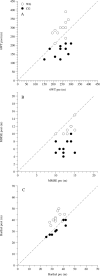Six-month walking program changes cognitive and ADL performance in patients with Alzheimer
- PMID: 21852281
- PMCID: PMC10845333
- DOI: 10.1177/1533317511418956
Six-month walking program changes cognitive and ADL performance in patients with Alzheimer
Abstract
Motor inactivity is typical in the later stages of Alzheimer's disease although there is evidence that physical exercise can reduce depression and enhance performance of daily activities. The aim of this study was to determine whether a walking program could reduce the functional and cognitive decline of elderly nursing home residents in the later stages of Alzheimer's disease. A total of 21 patients (84 ± 5 years) were randomly assigned to a walking program (WG) or to a control group (CG). A 6-minute walking test (6WT), the Barthel index of activities of daily living (ADLs), and Mini-Mental State Examination (MMSE) tests were performed before and after 24 weeks of the program. The WG showed significant improvement in the 6WT (20%) and ADLs (23%), while the CG decreased in MMSE (-47%), the WG had a slower decline (-13%). This study indicates that it is possible to stabilize the progressive cognitive dysfunctions in nursing home residents with Alzheimer's disease through a specific walking program.
Conflict of interest statement
The author(s) declared no potential conflicts of interest with respect to the research, authorship, and/or publication of this article.
Figures



References
-
- Dechamps A, Diolez P, Thiaudiere E, et al. . Effects of exercise programs to prevent decline in health-related quality of life in highly deconditioned institutionalized elderly persons: a randomized controlled trial. Arch Intern Med. 2010;170(2):162–169. - PubMed
-
- Aoyagi Y, Park H, Park S, Shephard RJ. Habitual physical activity and health-related quality of life in older adults: interactions between the amount and intensity of activity (the Nakanojo Study). Qual Life Res. 2010;19(3):333–338. - PubMed
-
- Venturelli M, Lanza M, Muti E, Schena F. Positive effects of physical training in activity of daily living-dependent older adults. Exp Aging Res. 2010;36(2):190–205. - PubMed
-
- Laurin D, Verreault R, Lindsay J, MacPherson K, Rockwood K. Physical activity and risk of cognitive impairment and dementia in elderly persons. Arch Neurol. 2001;58(3):498–504. - PubMed
Publication types
MeSH terms
Substances
LinkOut - more resources
Full Text Sources
Medical

